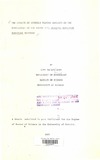| dc.description.abstract | In insects, egg maturation, growth, development and
metabolic processes are known to be controlled by hormones
secreted by the neuroendocrine system. The insect neuroendocrine
system consists of the antero-medial neurosecretory cells
of the brain, ¢orpus cardiac¢um (or the neurohaemal organ),
corpus allatum and prothoracic glands. During development
the brain neurosecret~ry cells produce neurosecretory Inaterlal
(or the brain hormone) which is stored in the Corpus cardiacum
from where it is released into the general circulation and
stimulates the endocrine glands which respond by secreting
their respective hormones that control various processes. Thus
the prothoracic glands secrete ecdysones and Corpora allata
secrete juvenile hormone. After the pro thoracic glands are
activated, ecdysones appear in the insects body and these
ecdysones cause the insect to moult, | en |

